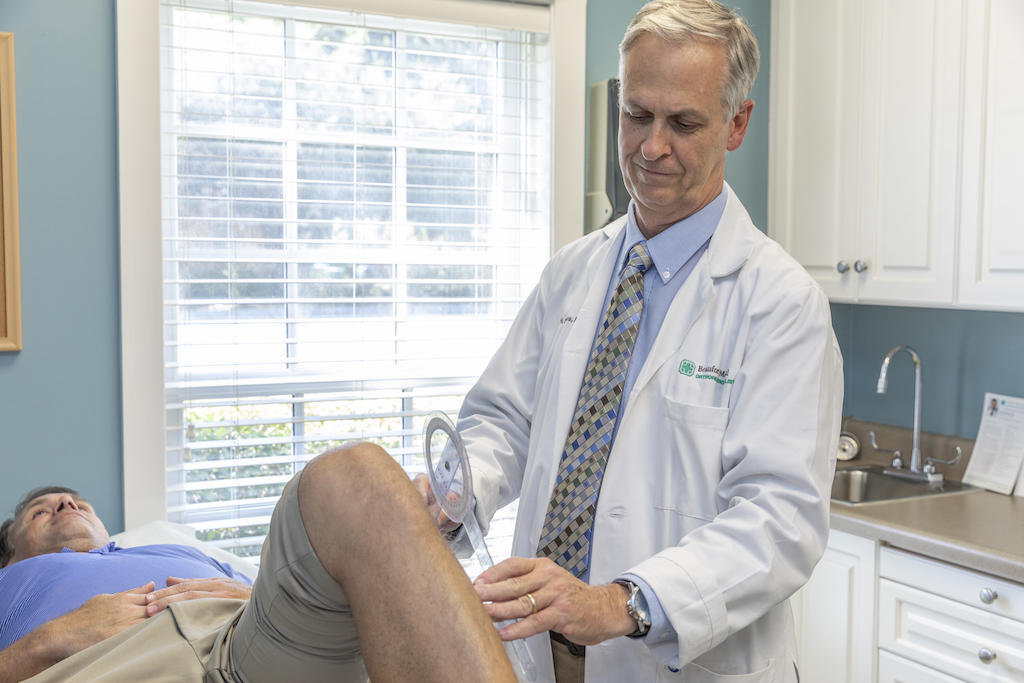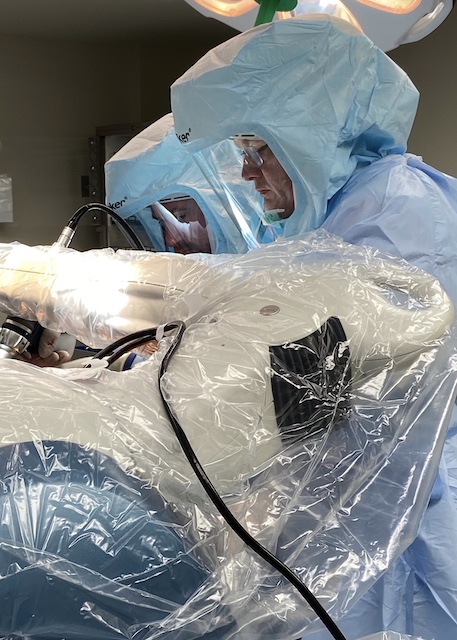More than 30 million Americans suffer from knee pain caused by degenerative joint disease. Also known as “wear and tear” arthritis, this debilitating condition occurs when the cartilage cushioning your joints wears down.
“When you don’t have cartilage in the joint, you have bone rubbing on bone,” said BMH board-certified orthopaedic surgeon Dr. Kevin Jones of Beaufort Memorial Orthopaedic Specialists in Okatie and Beaufort. “The pain can be pretty severe.”
Jones is one of five Beaufort Memorial surgeons now using the hospital’s cutting edge Mako SmartRobotics™ system to customize and improve total knee replacements. The other physicians trained in the technology are Drs. Edward Blocker, Vandit Sardana and Leland Stoddard, also of Beaufort Memorial Orthopaedic Specialists, and Dr. Carson Sanders of Beaufort Sports & Spine Center.
“With the robot, we can more closely customize the ideal position of the knee implant, increasing its longevity,” said Blocker, chairman of the hospital’s orthopaedic department. “We’ve been watching this technology for a long time and think it clearly offers a benefit.”
Blocker performed the hospital’s first robotic-assisted knee replacement surgery last year and has been impressed with the improved outcomes he has seen with his patients.
As with all robotic surgeries, the doctor is in control of the robot at all times during the knee replacement procedure. “The robot does not perform the surgery, make decisions, or move on its own,” Jones said. “But the advantage of using the new technology is that the surgeon can guide the robot’s instrument arm with a new level of accuracy for the alignment and position of the artificial joint.”
Dr. Edward Blocker performs the first MAKO knee replacement surgery at Beaufort Memorial last January. The hospital will be adding robotic-assisted hip replacement later this month.
And that’s just one of many benefits. “With the technology’s software,” Blocker said, “we can create a personalized pre-operative plan for the patient and implant the prosthetic knee components with greater precision, with the goal being better function and more natural movement.”
Prior to the surgery, a CT scan is taken of the knee to create a 3-D virtual model of the patient’s unique joint. The surgeon uses the model to evaluate bone structure, disease severity, joint alignment and the surrounding bone and tissue to determine the optimal size, placement and alignment of the implant.
During the operation, the surgeon follows the preoperative plan, guiding the robotic instrument arm to remove only the diseased bone. A virtual boundary established by the robot prevents the surgeon from crossing the bone field into surrounding tissue, preserving the healthy bone and ligaments around it.
“There’s less irritation of the soft tissue,” said Jones, who advocated for Beaufort Memorial’s use of the robotic system. “Less soft-tissue irritation could translate to less pain.”
Once the arthritic bone and cartilage are removed, the surgeon implants the total knee components into their preplanned positions. With the Mako system’s dynamic joint balancing capability, the surgeon can check the implant component positions and make adjustments to the plan as needed to customize them to the patient.
“We can move the knee through a range of motion and see it on the computer screen,” Blocker said. “It allows us to quantifiably measure the tension of the ligaments on each side of the joint and tweak it if it’s not perfect. Ligament balance is key to a successful long-term outcome.”
More than 1 million total joint replacement procedures are performed in the United States each year. By 2030, that number is expected to grow 637 percent to 3.5 million procedures annually.
From January 2020 through May 2021, 367 knee replacements have been performed at Beaufort Memorial using the Mako SmartRobotics™ system. Later this month, the hospital will begin offering the technology for hip replacements as well.
“I had great outcomes with the Mako hip replacement surgeries I performed during my fellowship in New York,” said Dr. Sardana, who joined the BMH orthopaedic surgical team in September 2018 after completing his fellowship training in joint replacement at Lenox Hill Hospital in Manhattan. “Using the robot helps you position the joint components in the right position. With well-positioned hip components, there’s less likelihood of hip dislocation following surgery.”
The robotic-assisted surgery is especially beneficial combined with a hip replacement technique known as the anterior approach. In this procedure, the surgeon operates from the front of the hip where there are fewer muscles. Rather than having to cut through muscle fibers and then repair them at the end of the surgery, the doctor can work between the muscles.
“With less muscle damage, patients typically experience less pain after surgery and recover more quickly,” said Sardana, who sees patients in Okatie and Beaufort. “It’s a huge benefit to the local community to be able to offer the advanced robotic technology combined with anterior hip replacement.”




